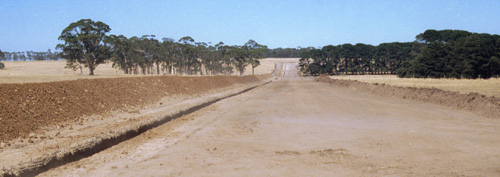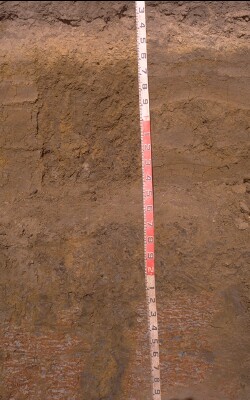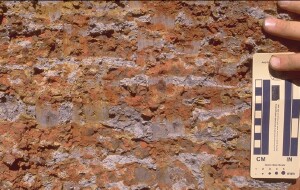SW67
Location: Irrewillipe
Australian Soil Classification: Bleached-Mottled (& Reticulate), Eutrophic, Brown CHROMOSOL
General Landscape Description: Weakly dissected coastal plain, gently inclined undulating plain.
Site Description: Gently sloping above broad plain.
Geology: Hanson Plain Sand

SW67 Landscape
Soil Profile Morphology:
Surface Soil
| A1 | 0-10 cm | Very dark gray (7.5YR3/1 moist), dark grayish brown (10YR4/2 dry); fine sandy loam; weakly pedal; weak consistence; pH 5.2; clear and irregular change to: |  SW67 Profile Note: Surface (A1) horizon has been stripped from profile |
A2 | 40-50/60 cm | Brown (10YR4/3 moist), yellowish brown (10YR5/4 dry) in upper part of horizon, tending to olive brown (2.5Y4/4 moist), light olive brown (2.5Y5/6 dry); fine sandy clay loam; occasional buckshot gravel in lower part of horizon and some manganiferous mottles or soft concretions; faint rusty mottles (~5 mm); weak consistence; pH 5.8; clear and wavy change to: | |
| Subsoil | |||
| B21t | 56/60-90/95 cm | Dark yellowish brown (10YR3/4 moist); with faint yellow and brown mottles; gravelly clay loam; fine polyhedral structure; firm consistence; friable in moist state; few (5-10%) fine to coarse rounded ironstone buckshot nodules (2-20 mm); pH 6; gradual change to: | |
B22tg | 90-95-120 cm | Dark grayish brown (10YR4/2 moist); with many (30-50%), yellowish brown (10YR5/8 moist) mottles; thick, dark brown (10YR3/3 moist) cutans; yellow, dull red and black ped interiors; manganese coatings on some ped faces and soft accumulations inside peds; diffuse change to: | |
B23g | 120-210/300 cm | Dark brown (10YR3/3 moist); common (<20%), yellowish brown (10YR5/8 moist) mottles with soft and hard manganiferous concretions (~20 mm) (5-10%); broad tongueing [300 mm] into B/C horizon; pH 6.3; clear to abrupt boundary and tongueing into: | |
B/C | 210/300+ cm | Conspicuous reticulate laminar mottling:"Tiger Mottles" red (10R4/6) and gray (2.5Y6/1). Lamellae 10-20 mm apart:a red matrix is rigid strongly cemented ferruginised sand, gray lamellae are soft sandy to clay. Margins of lamellae are often yellow (10YR7/8) to yellowish brown (10YR5/8). Red matrix frequently presents as angular ironstone gravel (10-20 mm). |

Tiger Mottles at 210 cm depth.
Key Profile Features:
- Conspicuously bleached subsurface (A2) horizon.
- Strong texture contrast between surface (A) horizon and subsoil (B2) horizon.
- “Tiger mottling” in deep subsoil (i.e. below 2 m depth).
Soil Profile Characteristics:
pH | Salinity Rating | |||
Surface (A1 horizon) | Strongly Acid | Very Low | Non-Sodic | None |
Subsoil (B21 horizon) | Moderately Acid | Very Low | Non-Sodic | None |
Deeper Subsoil (at 120-140 cm) | Slightly Acid | Very Low | Non-Sodic | None |

| The surface is strongly acid. The subsoil is moderately acid becoming slightly acid with depth. | Salinity rating is very low throughout the profile. | The soil is non sodic throughout. | Exchangeable Aluminium levels are high in the surface soil. | Clay levels jump markedly at the surface / subsoil boundary. |
Horizon | Sampling Depth (cm) | pH (water) | pH (CaCl2) | EC 1:5 | Organic Carbon % | Nitrogen % | Exchangeable Cations | |||
Ca | Mg | K | Na | |||||||
meq/100g | ||||||||||
A1 | 0-10 | 5.2 | 4.4 | 0.09 | 3.6 | 0.26 | 2.1 | 0.86 | 0.11 | 0.22 |
A2 | 40-50 | 5.8 | 4.8 | <0.05 | 2.1 | 0.88 | <0.05 | 0.08 | ||
B21 | 70-85 | 6 | 5.2 | 0.06 | 2.8 | 7.3 | 0.12 | 0.45 | ||
B23 | 120-140 | 6.3 | 5.4 | 0.06 | ||||||
Horizon | Sampling Depth (cm) | Exchangeable Aluminium mg/kg | Exchangeable Acidity meq/100g | Field Capacity pF2.5 | Wilting Point pF4.2 | Coarse Sand (0.2- 2.0 mm) | Fine Sand (0.02- 0.2 mm) | Silt (0.002- 0.02 mm) | Clay (<0.002 mm) |
A1 | 0-10 | 130 | 17 | 23.7 | 9 | 8.8 | 53.6 | 13 | 18 |
A2 | 40-50 | 18 | 6.9 | 20.3 | 7 | 11.5 | 54.7 | 12.5 | 18.5 |
B21 | 70-85 | <10 | 12 | 37.4 | 25.4 | 3.5 | 21 | 7 | 67 |
B23 | 120-140 |
Profile Described By: Richard McEwan (March 1999).


